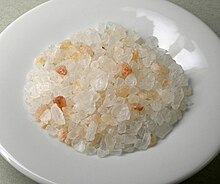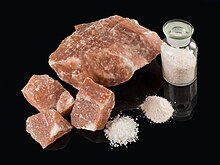Himalayan salt
Himalayan salt is a trade name for pink (iron ion-containing) rock salt that is mainly offered as table salt in health food stores , natural food and esoteric shops .
Like other raw (unrefined) rock salts, it consists of 97 to 98 percent sodium chloride and a small proportion of about seven other minerals such as gypsum and accompanying sulfates and sylvine ( potassium chloride ). It owes its reddish color to the iron ions of a small proportion of iron oxide impurities . The Himalayan salt does not offer any health benefits.
Most of the mining takes place in the Khewra salt mine in the Salt Mountains , a low mountain range in the Pakistani province of Punjab , 200 kilometers southwest of the Himalayan mountains . The mine opens up one of the largest rock salt deposits in the world. Salt has been mined commercially since the 16th century at the latest. A smaller part of the products sold as Himalayan salt comes from Polish mining.
offer
Himalayan salt is finely ground, offered as granules or in the form of halite lumps . Salt lamps are also made from chunks of halite. The product is known as Alexander salt, because legend has it that the Khewra deposit was discovered by the horses in the army of Alexander the Great . The same reference to the special is conveyed by terms such as Hunza crystal salt , imperial salt or crystal salt .
Questions of origin
The product was previously marketed as "Lahoresalz" (after the nearby town ). Himalayan salt as a designation of origin is misleading for the consumer. The reference from the mining site in the salt mountains in Punjab to the highest mountains on earth ( Karakoram area ) is only effective in advertising and is esoterically significant. In addition, the impression is reinforced by appropriate references. “As the regional court correctly stated, the average German consumer associates the term 'Himalaya' with the idea of a high mountain region with the highest elevations on earth. The presentation with the image of a snow-capped peak reinforces this idea. [...] On the other hand, the mining of the rock salt offered by the defendant is undisputedly taking place in open-cast mining in a hilly landscape around 200 km away, separated from the Himalayan massif by a densely populated plain. No particularly attentive consumer, who deciphers the English-language text on the label, expects that to be the case, referring to the salt mines of Alexander the Great in the regions of Karakoram (with the second highest mountain on earth) and Kashmir (in the Hindu Kush). "
Attributed mode of action
Himalayan salt became popular through Peter Ferreira's (pseudonym of the author and businessman Peter Druf) published in October 2001 book Water and Salt, Urquell des Lebens , in which it is praised as a panacea for diseases of civilization when used regularly . It can even correct malnutrition , such as too much table salt. The main reason for this is that this salt contains 84 chemical elements in a similar mixing ratio as human blood. In addition, the salt has the same "energetic vibrations" as the human organism and it is assigned a special "information content". Allegedly this information is confirmed by an "Institute of Biophysical Research" based in Las Vegas, USA, which cannot be found. At the same time, Ferreira was the owner of Lichtkraft, one of the largest distributors of Himalayan salt products.
Scientific assessment
In 2002 the Bavarian State Office for Health and Food Safety examined 15 different samples of the Himalayan salt and found that on average it consists of around 98% sodium chloride. The proportion of other minerals and trace elements is comparable to that of sea salt, which is why it cannot make a relevant contribution to meeting the daily needs of these minerals and trace elements. The ZDF magazine WISO has 2,006 samples of the so-called Himalayan salt on the year Technical University of Clausthal be examined. Only ten elements were found there too. In addition, the sample examined contained polyhalite , a complex sulfate mineral , as an impurity .
“The chemical composition of the salt does not differ in any way from other natural rock salts. It differs from the well-known kitchen salt only in that it contains more impurities. "
Contrary to what is claimed, there are fewer than 30 elements in the human body - about ten elements make up practically the entire body substance, eleven elements are essential trace elements, for example as part of enzymes . Some other elements occur in traces depending on the environmental conditions, but play no role or a damaging role for the metabolism . The heavy metals mercury, lead and cadmium are particularly damaging .
There is no scientific evidence to support the claimed health benefits of crystal salt. There is no evidence that heavy metals or deposits in the vessels ( arteriosclerosis ) could be flushed out of the body with brine solution . Sufficient salt is consumed with the usual diet in Central Europe; additional intake can put a strain on the metabolism and the kidneys. The statement that it is possible to lower high blood pressure ( arterial hypertension ) with the help of crystal salt is scientifically untenable. This also applies to statements regarding an alleged hyperacidity of the body.
Himalayan salt contains - like all table salt - apart from chloride and sodium, only small traces of other minerals . It makes practically nothing to cover the daily need for other minerals.
"To call crystal salt 'rich in minerals' is simply misleading the consumer."
According to the Association of Nutritionists Austria , two teaspoons of Himalayan salt contain 45 mg calcium (daily requirement: 1000 mg), 5 mg magnesium (daily requirement: 300 mg) and 0.7 mg iron (daily requirement: 10 mg).
Despite its average composition, Himalayan salt is sold at around twenty times the price of common table salt. Öko-Test and Stiftung Warentest deny that the Himalayan salt has any special effects and see it as “bad business dealings” or misleading the consumer.
Web links
- The consumer advice center Baden-Württemberg about Himalayan salt
- White gold of the Himalayas in the news magazine Focus
Individual evidence
- ^ Petrography. Formation, composition and change of the rocks by Justus Roth , p. 558: “Punjub, Saltrange. Rothe marl with rock salt, gypsums and some dolomite. In the Mayo salt mines, Khewra, there are also sylvin , kieserite , glauberite , blödit . Medlicott and Blanford. Geolog. of India. 1878, II, 486 ".
- ↑ What is it about Himalayan salt and Co.? on Wissen.de .
- ↑ “The salt which this chain supplies is partly clear and transparent like crystal, and at the same time so hard that bowls for eating and other utensils are made out of it, which is why it is also popular in Kashmir, partly it is eastward of brownish color and is sold in East India under the name Lahoresalz. ” General Encyclopedia of Sciences and Arts , published by JSErsch and JGGruber, Third Section, Siebzehnter Theil, FA Brockhaus, Leipzig 1842, keyword Peshawer, p. 295.
- ↑ Ludmilla Tüting on the Himalayan salt .
- ↑ Cologne Higher Regional Court, judgment of October 1, 2010 - 6 U 71/10 .
- ↑ White Gold of the Himalayas in Focus No. 11 (2002).
- ↑ Crystal salt on everyone's lips, steep prices in all shops - and who benefits? Article by Walter von Holst in the magazine ZeitGeist from October 2002 ( online ; PDF; 126 kB).
- ↑ Bavarian State Office for Health and Food Safety: Annual Report 2002 p. 104
- ↑ a b ZDF: Expensive wort from the Himalaya (2006) ( Memento from October 24, 2006 in the Internet Archive )
- ↑ Distribution of elements in the human body , FU Berlin
- ↑ a b The business with the Himalayan salt , UGB
- ↑ a b VEÖ: The rip with the Himalayan salt (2003) ( Memento from October 9, 2007 in the Internet Archive ) (PDF; 137 kB).
- ↑ Healthier through Himalayan salt? ( Memento of the original from February 22, 2014 in the Internet Archive ) Info: The archive link was automatically inserted and not yet checked. Please check the original and archive link according to the instructions and then remove this notice. , Öko-Test 7/2002, p. 126
- ↑ Himalayan Salt - Faith Question , Stiftung Warentest, in: test 10/2002, p. 17.


